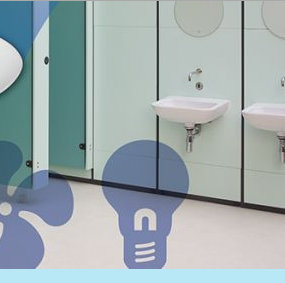
Latest regulations & advice on workplace restrooms & public toilets
Water management experts Cistermiser offer a handy Q&A to ensure you are following the law and keeping costs to a minimum when installing public toilets and workplace restrooms.
What is the law surrounding toilets in a workplace?
Legislation in regards to toilets in a workplace are set out by the government in their document Workplace (Health, Safety and Welfare) Regulations 1992. Regulation 20, Sanitary Conveniences.
Within this regulation, it is stated that readily accessible places must have suitable and sufficient sanitary conveniences provided. To be suitable, these facilities have to:
- Be adequately ventilated and lit.
- Be kept in a clean and orderly condition.
- Have separate rooms which contain conveniences for men and women, or rooms separated by a door which can be secured from the inside.
Check out this Health and Safety Executive article for full details on the number of toilets and washbasins that a workplace must have, in regards to the number of people at work and their gender.
Why is it important to have public toilets?
According to The Provision of Public Toilets — a report ordered by the House of Commons — public toilets are particularly beneficial to older people and disabled citizens.
For older people, Pamela Holmes, the Head of Healthy Ageing at Help The Aged, stated: “We have research…about the impact on isolation, about the impact on older people’s health — physical, social and mental — when they are unable to go out of the house because they are fearful of not finding a public toilet.”
When it comes to disabled people, the National Association for Colitis and Crohn’s Disease, acknowledged: “Ulcerative Colitis and Crohn’s Disease, known collectively as Inflammatory Bowel Disease (IBD), affects approximately 1 in 400 people living in the UK…The sudden and uncontrollable need to use a toilet is a genuine and recognised symptom of IBD…Having an ‘accident’ in public is every patient’s worst fear and can have a devastating effect on their ability to undertake everyday activities such as going to work, shopping or socialising.”
Ensure you are catering to the needs of every customer by having suitable and sufficient public restrooms in operation in your facility.
How can I reduce the amount of water my toilet uses?
A great way to save water when it comes to toilets is to look at the amount of water that is being used when flushing. As this report by Home Water Works highlights, this is because…
- A toilet made before 1980 is known to use between five and seven gallons of water per flush
- A toilet manufactured between 1980 and 1992 will typically use 3.5 gallons of water per flush
- An Ultra Low Flush Toilet (or ULF for short) will use a maximum of 1.6 gallons of water per flush
- A High Efficiency Toilet (otherwise known as a HET) uses at most 1.3 gallons of water per flush
- A modern Dual-Flush toilet (whereby a full flush and a half flush can be operated) uses 1.1 gallons of water or fewer per flush, on average
As the average person will flush five times a day, changing the toilets within your workplace could change your monthly water bills significantly.
Cistermiser Ltd
Unit 1, Woodley Park Estate
59-69 Reading Road
Woodley, Reading
Berkshire RG5 3AN
t: +44(0) 118 969 1611
f: +44(0) 118 944 1426
Latest news

29th April 2025
Senior pledges to ‘bee’ part of the solution with new biodiversity initiative
Senior Architectural Systems has installed its first on-site beehive, marking another step forward in its commitment to sustainability and biodiversity.
Posted in Articles, Building Industry News, Building Products & Structures, Building Services, Curtain Walling, Doors, Glass, Glazing, Innovations & New Products, news, Restoration & Refurbishment, Retrofit & Renovation, Sustainability & Energy Efficiency, Walls, Windows
29th April 2025
West Fraser range delivering key benefits for South-East carpentry company
An experienced carpenter and building site manager who has recently set up his own company is using high performance panel products from the West Fraser range.
Posted in Articles, Building Industry News, Building Products & Structures, Building Systems, Case Studies, Garden, Restoration & Refurbishment, Retrofit & Renovation, Sustainability & Energy Efficiency, Timber Buildings and Timber Products
29th April 2025
CPD Courses Available Online From Ecological Building Systems
Ecological Building Systems, a leading supplier of natural building products for sustainable construction, has revealed its comprehensive CPD programme for the year ahead.
Posted in Articles, Building Industry Events, Building Industry News, Building Products & Structures, Building Services, Continuing Professional Development (CPD's), Information Technology, Innovations & New Products, Insulation, Restoration & Refurbishment, Retrofit & Renovation, Seminars, Sustainability & Energy Efficiency, Training, Walls, Waste Management & Recycling
29th April 2025
WindowBASE launches new prospect databases at FIT Show
Visit WindowBASE at the FIT Show to see first-hand how it helps companies find new customers – the company is launching an easy-to-use, intuitive platform on Stand G16 at the NEC Birmingham from 29th April – 1st May.
Posted in Articles, Building Industry Events, Building Industry News, Building Products & Structures, Building Services, Doors, Exhibitions and Conferences, Glass, Glazing, Information Technology, Innovations & New Products, Posts, Publications, Research & Materials Testing, Restoration & Refurbishment, Retrofit & Renovation, Windows
 Sign up:
Sign up: